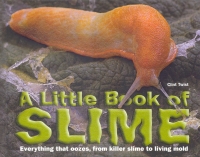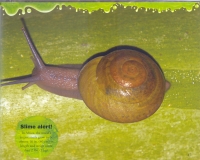| ________________
CM . . .
. Volume XVIII Number 41. . . .June 22, 2012
excerpt:
This book will treat readers to a disgusting subject: slime. The “sticky, semi-liquid substance” produced by living organisms is described throughout the book as “gloopy green scum”, smelly, “some of it is poisonous”, slippery, “a blob of gunk” or “utterly revolting.” In spite of all that gross press, readers will discover that slime is everywhere, essential for keeping bodies of amphibians, slugs and snails moist, for collecting food (the sundew plant) and as a defensive tool (poison arrow frog). The author has created “slime-ometer ratings between 1 and 10” with the higher rating given to the most offensive slime. Three sections divide the text: Slimy Stuff in Water, Slimy Stuff on Land and Other Slimy Stuff.
The writing style is perfect for this subject matter: straightforward and easy to understand, with wry humour to add interest: “When walking through a tropical rainforest, you never know what is going to drip down and fall onto your head. If you are very unlucky, it will be a great big drop of slimy wriggling tadpoles.” Besides the more familiar types of slime and slime-producers – red tide, jellyfish, banana slug, saliva – readers will encounter gruesome things, such as the horrible hagfish that produces the world’s strongest slime, the starfish stinkhorn whose slime stinks like sewage and rotting meat, and living snot mold which doesn’t make slime, it is slime. Slime is not exclusive to other animals and plants; it’s ours too. Phlegm is a sign of ill health, and saliva helps us chew and swallow. Colourful slime is produced by the bacteria that decompose dead plants and animals. This fascinating book will give readers loads of information with which to amaze their friends. Kids will especially enjoy the ‘gross factor’ which starts with the cover, showing a slug done in a 3-D textured effect, with raised lettering for the title in, what else, slime green. Here’s an excellent science resource on a topic about which many of us know little. Highly Recommended. Gillian Richardson is a freelance writer living in BC.
To comment
on this title or this review, send mail to cm@umanitoba.ca.
Copyright © the Manitoba Library Association. Reproduction for personal
use is permitted only if this copyright notice is maintained. Any
other reproduction is prohibited without permission.
NEXT REVIEW |
TABLE OF CONTENTS FOR THIS ISSUE
- June 22, 2012.
AUTHORS |
TITLES |
MEDIA REVIEWS |
PROFILES |
BACK ISSUES |
SEARCH |
CMARCHIVE |
HOME |

 Subheadings within each section follow a similar pattern (see the excerpt) to describe the essential details of various kinds of slime. Each double-page description includes facts in short chunks, a close-up photo and a full page shot, with an extra amazing fact in a Slime Alert bubble. A glossary of terms shown in bold type and an index complete the book.
Subheadings within each section follow a similar pattern (see the excerpt) to describe the essential details of various kinds of slime. Each double-page description includes facts in short chunks, a close-up photo and a full page shot, with an extra amazing fact in a Slime Alert bubble. A glossary of terms shown in bold type and an index complete the book.